As digital wallets and mobile payments reshape our spending habits, Buy Now, Pay Later (BNPL) services have surged into prominence. These platforms promise seamless purchase flexibility and a new way to manage cash flow when dollars feel tight. But behind the ease lies a complex ecosystem worth exploring.
From rapid market growth to regulatory scrutiny, BNPL apps demand a critical look. Are they practical budgeting tools or a gateway to unintended debt? Let’s dive into trends, data, and real user insights to answer that question.
Market Growth and Future Forecasts
The global BNPL payment market is projected to reach $560.1 billion by 2025, reflecting a remarkable 13.7% year-over-year increase. With a compound annual growth rate (CAGR) of 21.7% between 2021 and 2024, this sector shows no signs of slowing, forecasted to maintain a 10.2% CAGR through 2030 and approach $911.8 billion.
In the United States, BNPL volumes are set to hit $122.26 billion in 2025, growing at a healthy 20.3% CAGR over recent years. While expected to moderate to an 8.5% CAGR through 2030, the market will still swell to $184.05 billion by decade’s end.
Who Uses BNPL? Understanding the Demographics
BNPL adoption is strongest among Gen Z and Millennials, reflecting a cohort that values digital solutions and flexible budgets. Urban families and individuals earning under $60,000 annually also gravitate toward these services, seeking manageable payments instead of large, upfront costs.
Notably, BNPL extends beyond fashion and electronics. Home improvement, school supplies, and even small business expenses are increasingly financed through installment plans. This broad usage underscores the appeal of spreading costs over time.
How BNPL Works: A Closer Look at the Mechanics
At its core, BNPL divides a purchase into equal installments—often four payments—starting at checkout. Many providers charge zero interest when bills are settled on time, and soft credit checks simplify approval without harming credit scores.
Revenue stems from merchant fees and, in some cases, late penalties or interest on extended plans. This model allows providers to offer consumers attractive terms while maintaining profitability.
Comparing the Major Players
Several apps dominate the BNPL landscape, each with nuanced differences in fees, terms, and retailer partnerships. The following table compares leading providers:
Pros and Cons for Consumers
BNPL can be a powerful tool when used responsibly, yet it carries inherent risks. Weigh these key advantages and drawbacks:
- No-interest installment plans encourage disciplined budgeting.
- Easy approval with minimal credit requirements makes it accessible.
- Flexible payments help manage cash flow during inflation.
- Integration at checkout often boosts convenience.
- Missed payments can trigger late fees and interest charges.
- The convenience may fuel impulsive spending tendencies.
- Extended financing options sometimes carry higher costs.
- Potential negative credit impacts if delinquency escalates.
Making the Right Choice: Practical Tips
To decide if BNPL suits your finances, follow these actionable steps to stay on track:
- Read all terms carefully, focusing on late fee structures and interest details.
- Set calendar reminders for each installment to avoid missed payments.
- Compare providers’ merchant networks to find the best match for your purchases.
- Limit BNPL use to planned expenses, not impulse buys.
Trends and Regulatory Considerations
E-commerce platforms increasingly embed BNPL at checkout to boost conversions and average order values. Technology giants and traditional banks are entering the space, intensifying competition and pushing down costs.
Meanwhile, regulators worldwide are scrutinizing BNPL’s rapid ascent. Concerns over transparent disclosures, consumer over-indebtedness, and fair lending practices are driving proposals for clearer terms and better borrower protections.
Conclusion
Buy Now, Pay Later apps undeniably offer unprecedented shopping flexibility, especially in a climate of stagnant wages and rising living costs. When used wisely, they can enhance budgeting and relieve cash flow pressures.
However, consumers must approach these tools with caution, fully aware of the potential pitfalls. By understanding market dynamics, reading the fine print, and maintaining disciplined repayment habits, BNPL can be an empowering component of a modern financial toolkit.
References
- https://www.globenewswire.com/news-release/2025/02/24/3031214/28124/en/Buy-Now-Pay-Later-Global-Business-Report-2025-BNPL-Payments-to-Grow-by-13-7-to-Surpass-560-Billion-this-Year-Driven-by-Klarna-Afterpay-PayPal-and-Affirm-Forecast-to-2030.html
- https://www.numerator.com/resources/blog/buy-now-pay-later-market-insights/
- https://www.persistencemarketresearch.com/market-research/buy-now-pay-later-market.asp
- https://www.businesswire.com/news/home/20250217649569/en/United-States-Buy-Now-Pay-Later-Market-Report-2025-Affirm-Afterpay-and-Klarna-Continue-to-Scale-their-Services-as-New-Entrants-and-Traditional-Financial-Institutions-Compete-for-Market-Share---ResearchAndMarkets.com
- https://www.coherentmarketinsights.com/market-insight/buy-now-pay-later-platforms-market-4013
- https://www.nerdwallet.com/article/loans/personal-loans/buy-now-pay-later
- https://straitsresearch.com/report/buy-now-pay-later-market
- https://www.investopedia.com/buy-now-pay-later-5182291










